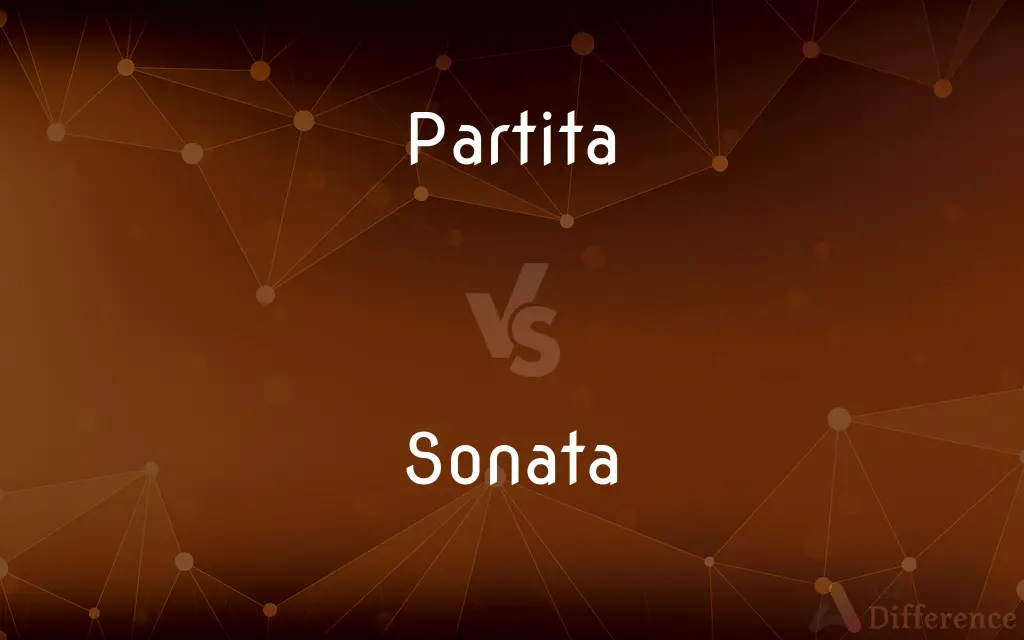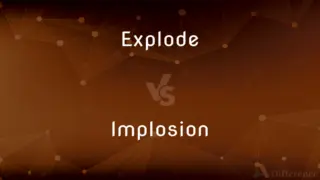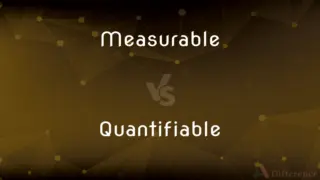Partita vs. Sonata — What's the Difference?
By Tayyaba Rehman & Fiza Rafique — Updated on March 29, 2024
A partita typically comprises a suite of dance-inspired movements, while a sonata is structured around contrastive musical themes and developments.

Difference Between Partita and Sonata
Table of Contents
ADVERTISEMENT
Key Differences
A partita is often a collection of various dance forms, each with its distinctive rhythm and mood, tailored to showcase the technical and expressive range of an instrument. On the other hand, a sonata focuses on the exploration and development of thematic material, usually within a three or four-movement structure, emphasizing contrast and cohesion.
While partitas usually adhere to a sequence of stylized dances like allemandes, courantes, sarabandes, and gigues, each movement maintaining a distinct dance rhythm, sonatas employ a wider variety of forms. These can include fast-moving, dramatic allegros, slow lyrical movements, minuets or scherzos, and lively finales, with each serving a unique role in thematic development.
Partitas, particularly those from the Baroque era, are deeply rooted in the courtly dance traditions of the time, offering a snapshot of the rhythmic and melodic styles favored in social dances. Sonatas, evolving significantly from the 18th century onwards, reflect a broader range of emotional and structural complexities, often designed to express the composer's most profound thoughts.
The performance context of partitas has traditionally been more flexible, suitable for both intimate chamber settings and solo performances. Sonatas, however, have played a pivotal role in concert repertoires, frequently performed in recitals as showcases of virtuosity and deep musical interpretation.
In terms of musical architecture, partitas are generally more predictable in their sequence of movements and adherence to dance forms. Sonatas, by contrast, are marked by their developmental sections, where themes are manipulated and transformed, leading to more unpredictable and complex structures.
ADVERTISEMENT
Comparison Chart
Origin
Baroque era, dance suite
Classical era, evolved from sonata da camera and sonata da chiesa
Movement Types
Dance forms (allemande, courante, sarabande, gigue)
Varied (allegro, adagio, scherzo, finale)
Structure
Sequence of dances, each with a distinct rhythm
Multi-movement, thematic development and contrast
Performance Context
Flexible, solo or chamber music
Concert setting, showcases virtuosity
Musical Aim
Showcasing technical and expressive range
Exploring and developing thematic material
Compare with Definitions
Partita
Rooted in social dance traditions.
Baroque partitas mirror the courtly dances of the 17th century.
Sonata
Typically consists of three to four movements with contrasting themes.
The sonata's first movement often introduces the main thematic material.
Partita
Often performed in both concert and intimate settings.
Partitas are adaptable, suitable for solo recitals or small gatherings.
Sonata
Has evolved through eras, reflecting changes in musical taste.
Romantic sonatas expanded the form to express greater emotional depth.
Partita
Features movements like allemande and sarabande.
Each movement in a partita contrasts in tempo and character.
Sonata
Integral to concert repertoires worldwide.
Sonatas are staples in the repertoires of classical musicians, highlighting their virtuosity.
Partita
Composed for solo instruments, reflecting baroque stylizations.
The violin partita emphasizes melodic intricacies and virtuosity.
Sonata
A complex musical composition for one or more instruments.
Beethoven’s Moonlight Sonata explores deep emotional contrasts.
Partita
A musical suite, traditionally of dance movements.
Bach's Partita No. 2 in D minor showcases baroque dance forms.
Sonata
Emphasizes thematic development and musical architecture.
Sonata form includes exposition, development, and recapitulation sections.
Partita
Partita (also partie, partia, parthia, or parthie) was originally the name for a single-instrumental piece of music (16th and 17th centuries), but Johann Kuhnau (Thomaskantor until 1722), his student Christoph Graupner, and Johann Sebastian Bach used it for collections of musical pieces, as a synonym for suite. Johann Sebastian Bach wrote two sets of partitas for different instruments.
Sonata
Sonata (; Italian: [soˈnaːta], pl. sonate; from Latin and Italian: sonare [archaic Italian; replaced in the modern language by suonare], "to sound"), in music, literally means a piece played as opposed to a cantata (Latin and Italian cantare, "to sing"), a piece sung.
Partita
An instrumental piece composed of a series of variations, as a suite.
Sonata
A composition for one or more solo instruments, one of which is usually a keyboard instrument, usually consisting of three or four independent movements varying in key, mood, and tempo.
Partita
One of the variations contained in such a piece.
Sonata
(music) A musical composition for one or a few instruments, one of which is frequently a piano, in three or four movements that vary in key and tempo.
Partita
(music) A type of instrumental suite popular in the 18th century
Sonata
An extended composition for one or two instruments, consisting usually of three or four movements; as, Beethoven's sonatas for the piano, for the violin and piano, etc.
Partita
A suite; a set of variations.
Sonata
A musical composition of 3 or 4 movements of contrasting forms
Common Curiosities
What is a partita?
A partita is a suite of baroque dance movements, composed for a solo instrument, showcasing a variety of dance forms.
Are partitas easier to perform than sonatas?
Not necessarily; both require technical skill and interpretive depth, but partitas focus on dance forms while sonatas emphasize thematic development.
Can partitas be played in modern concerts?
Yes, partitas are often performed in both solo recitals and chamber music settings in modern concerts.
Were partitas popular in a specific historical period?
Partitas were especially popular during the Baroque era, reflecting the period's dance traditions.
How many movements does a typical sonata have?
A typical sonata has three to four movements, each with distinct tempos and characters.
Do sonatas require accompaniment?
Sonatas can be for solo instruments or include accompaniment, such as a piano sonata with a piano accompaniment.
What distinguishes a sonata from a partita?
A sonata is structured around thematic development across multiple movements, whereas a partita consists of a series of dance movements.
How do sonatas express thematic material?
Sonatas use exposition, development, and recapitulation sections to introduce, explore, and conclude thematic material.
Can partitas contain movements that are not dances?
While uncommon, some partitas may include non-dance movements, though they predominantly feature dance forms.
What types of instruments can play partitas?
Partitas are primarily written for solo instruments like the violin, keyboard, and flute.
Is the sonata form rigid in its structure?
While sonata form has basic principles, composers have often varied its structure creatively.
How do performers approach the interpretation of partitas and sonatas?
Performers approach partitas by emphasizing their dance-like qualities and sonatas by highlighting their thematic and structural complexities.
What makes a partita distinct from other baroque suites?
Partitas are similar to other baroque suites but were often titled as such by specific composers, like Bach, to denote collections of dances.
How has the sonata evolved over time?
The sonata has evolved from its baroque origins to embrace wider emotional and structural ranges, reflecting changes in musical tastes.
What role does the piano play in sonatas?
The piano is a central instrument in many sonatas, either as a solo instrument or in partnership with others.
Share Your Discovery

Previous Comparison
Explode vs. Implosion
Next Comparison
Measurable vs. QuantifiableAuthor Spotlight
Written by
Tayyaba RehmanTayyaba Rehman is a distinguished writer, currently serving as a primary contributor to askdifference.com. As a researcher in semantics and etymology, Tayyaba's passion for the complexity of languages and their distinctions has found a perfect home on the platform. Tayyaba delves into the intricacies of language, distinguishing between commonly confused words and phrases, thereby providing clarity for readers worldwide.
Co-written by
Fiza RafiqueFiza Rafique is a skilled content writer at AskDifference.com, where she meticulously refines and enhances written pieces. Drawing from her vast editorial expertise, Fiza ensures clarity, accuracy, and precision in every article. Passionate about language, she continually seeks to elevate the quality of content for readers worldwide.














































